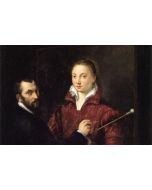Art in the age of Napoleon: politics, painting & propaganda
- Course Code: VB618
- Dates: 27/04/24 - 27/04/24
- Time: 11:00 - 17:00
- Taught: Sat, Daytime
- Duration: 1 session
- Location: Keeley Street
- Tutor: Rachel Sanders
Course Code: VB618
Duration: 1 session
Note: Course starts today, check start time
Please note: We offer a wide variety of financial support to make courses affordable. Just visit our online Help Centre for more information on a range of topics including fees, online learning and FAQs.
What is the course about?
Napoleon was a master propagandist who fully exploited the talents of France’s leading painters, such as Gros and David, who had honed his skills during the French Revolution. This was the era of war and political turmoil, of Neo-Classical dominance, and the birth of Romanticism.
This one-day course examines the paintings and sculptures of those who supported the emperor and those who considered him an enemy, including Canova, Girodet and Géricault. Through analysis of famous works such as David’s Napoleon Crossing the Alps, we will chart the relationship art and the establishment and consider how effectively political aims were met.
What will we cover?
• David’s history paintings and portraits produced during the French Revolution and Napoleonic
• Napoleon’s propaganda in paintings by David’s students including Drouais, Girodet and Ingres, and in the sculpture of Canova
• The development of Neo-classicism, with focus on historic context and the influence of Winckelmann and the antique.
• The emergence of Romanticism in the Napoleonic images of Gros and Goya.
What will I achieve?
By the end of this course you should be able to...
• List the characteristics of Neo-Classicism – formal, subject, influences and aims
• Discuss the cultural and political contexts that shape Napoleonic art
• Assess the significance of Napoleonic art on the political landscape.
What level is the course and do I need any particular skills?
This course is suitable for all levels.
You should be able to follow simple written and verbal instructions, demonstrations, hand-outs and health and safety information, and will be invited to take part in group discussion.
How will I be taught, and will there be any work outside the class?
You will be taught with slide presentations and group discussions.
Are there any other costs? Is there anything I need to bring?
You might wish to bring a notebook. You might wish to buy some of the books on any reading list given out in class.
When I've finished, what course can I do next?
The Victorians: art, fashion & architecture
Change must come: politics, society and art
Art and revolution in the long 18th century.
Dr Rachel Sanders received her MA and PhD in History of Art from University College, London. She has taught at a number of institutions and currently lectures on the history of art and design at City Lit and Oxford Brookes University. Her research interest is early twentieth-century American political paintings and cartoons. She has published a number of articles on her research specialism and is currently writing a book on New Masses magazine.
Please note: We reserve the right to change our tutors from those advertised. This happens rarely, but if it does, we are unable to refund fees due to this. Our tutors may have different teaching styles; however we guarantee a consistent quality of teaching in all our courses.
